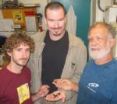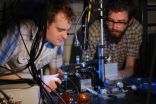(Press-News.org) The Arctic sea ice cover appears to have reached its minimum extent for the year, the third-lowest recorded since satellites began measuring sea ice extent in 1979, according to the University of Colorado at Boulder's National Snow and Ice Data Center.
While this year's September minimum extent was greater than 2007 and 2008, the two record-setting and near-record-setting low years, it is still significantly below the long-term average and well outside the range of natural climate variability, according to CU-Boulder's NSIDC scientists. Most researchers believe the shrinking Arctic sea ice is tied to warming temperatures caused by an increase in human-produced greenhouse gases being pumped into Earth's atmosphere.
On Sept. 10 the sea ice extent dropped to 1.84 million square miles, or 4.76 million square kilometers, and is likely the lowest ice extent of the year as sea ice appears to have begun its annual cycle of growth.
The 2010 minimum ice extent is 93,000 square miles, or 240,000 square kilometers, above the 2008 numbers and 240,000 square miles, or 630,000 square kilometers, above the record low in 2007. The 2010 sea ice extent is 130,000 square miles, or 340,000 square kilometers, below 2009, according to Serreze.
"We are still looking at summers with an ice-free Arctic Ocean in perhaps 20 to 30 years," said Serreze, also a professor in CU-Boulder's geography department.
The 2010 minimum is 753,000 square miles, or 1.95 million square kilometers, below the 1879-2000 average minimum and 625,000 square miles, or 1.62 million square kilometers, below the 1979 to 2010 average minimum.
Since NSIDC researchers determine the minimum sea ice extent using a five-day running average, there is still a small chance the sea ice extent could fall slightly, said Serreze. CU-Boulder's NSIDC will provide more detailed information in early October with a full analysis of the 2010 Arctic ice conditions, including aspects of the melt season and conditions heading into the winter ice-growth season.
INFORMATION:
NSIDC is part of CU-Boulder's Cooperative Institute for Research in Environmental Sciences -- a joint institute of CU-Boulder and the National Oceanic and Atmospheric Administration -- and is funded primarily by NASA.
For more information contact NSIDC's Jane Beitler at 303-492-1497 or Jim Scott in the CU-Boulder Office of News Services at 303-492-3114.
Arctic sea ice reaches lowest 2010 extent, third lowest in satellite record
2010-09-16
ELSE PRESS RELEASES FROM THIS DATE:
Stress accelerates breast cancer progression in mice
2010-09-16
Chronic stress acts as a sort of fertilizer that feeds breast cancer progression, significantly accelerating the spread of disease in animal models, researchers at UCLA's Jonsson Comprehensive Cancer Center have found.
Researchers discovered that stress is biologically reprogramming the immune cells that are trying to fight the cancer, transforming them instead from soldiers protecting the body against disease into aiders and abettors. The study found a 30-fold increase in cancer spread throughout the bodies of stressed mice compared to those that were not stressed. ...
'Warrior worms' discovered in snails; UCSB scientists see possible biomedical applications
2010-09-16
(Santa Barbara, Calif.) –– Scientists at UC Santa Barbara have discovered a caste of genetically identical "warrior worms" –– members of a parasitic fluke species that invades the California horn snail. The findings are reported in the early online version of the Proceedings of the Royal Society B.
"We have discovered flatworms in colonies with vicious, killer morphs defending the colony," said Armand M. Kuris, professor of zoology, in the Department of Ecology, Evolution and Marine Biology. "These flukes have a strongly developed social organization, much like some insects, ...
Fish schools and krill swarms take on common shape
2010-09-16
When fish or tiny, shrimp-like krill get together, it appears they follow the same set of "rules." According to a new study published online on September 16th in Current Biology, a Cell Press publication, shoals of fish and swarms of krill hang out in groups that take on the same overall shape; it's not a simple sphere, a cylinder, or ovoid, but something more akin to an irregular crystal, the researchers say.
"The fact that several species of fish and krill that live in very different locations—from the tropics to polar oceans—form shoals that are the same shape suggests ...
Night lights affect songbirds' mating life
2010-09-16
In today's increasingly urbanized world, the lights in many places are always on, and according to a report published online on September 16 in of Current Biology, a Cell Press publication, that's having a real impact on the mating life of forest-breeding songbirds.
"In comparison to chemical and noise pollution, light pollution is more subtle, and its effects have perhaps not received the attention they deserve," said Bart Kempenaers of the Max Planck Institute for Ornithology in Germany. "Our findings show clearly that light pollution influences the timing of breeding ...
Brain matter linked to introspective thoughts
2010-09-16
VIDEO:
This is an informal conversation with Mr. Stephen Fleming . This video relates to an article that is appearing in the Sept. 17, 2010, issue of Science, published by AAAS....
Click here for more information.
A specific region of the brain appears to be larger in individuals who are good at turning their thoughts inward and reflecting upon their decisions, according to new research published in the journal Science. This act of introspection—or "thinking about your ...
Optical chip enables new approach to quantum computing
2010-09-16
An international research group led by scientists from the University of Bristol has developed a new approach to quantum computing that could soon be used to perform complex calculations that cannot be done by today's computers.
Scientists from Bristol's Centre for Quantum Photonics have developed a silicon chip that could be used to perform complex calculations and simulations using quantum particles in the near future. The researchers believe that their device represents a new route to a quantum computer – a powerful type of computer that uses quantum bits (qubits) ...
Moon's craters give new clues to early solar system bombardment
2010-09-16
PROVIDENCE, R.I. [Brown University] — Take a cursory look at the moon, and it can resemble a pockmarked golf ball. The dimples and divots on its surface are testament that our satellite has withstood a barrage of impacts from comets, asteroids and other space matter throughout much of its history. Because the geological record of that pummeling remains largely intact, scientists have leaned on the moon to reconstruct the chaotic early days of the inner solar system.
Now a team led by Brown University planetary geologists has produced the first uniform, comprehensive catalog ...
'Archeologists of the air' isolate pristine aerosol particles in the Amazon
2010-09-16
Cambridge, Mass. and Manaus, Brazil – September 16, 2010 – Environmental engineers who might better be called "archeologists of the air" have, for the first time, isolated aerosol particles in near pristine pre-industrial conditions.
Working in the remote Amazonian Basin north of Manaus, Brazil, the researchers measured particles emitted or formed within the rainforest ecosystem that are relatively free from the influence of anthropogenic, or human, activity.
The finding, published in the September 16 issue of Science, could provide crucial clues to understanding cloud ...
MIT researchers discover an unexpected twist in cancer metabolism
2010-09-16
CAMBRIDGE, Mass. -- In a paper appearing in the Sept. 16 online edition of Science, Matthew Vander Heiden assistant professor of biology and member of the David H. Koch Institute for Integrative Cancer Research at MIT and researchers at Harvard University report a previously unknown element of cancer cells' peculiar metabolism. They found that cells can trigger an alternative biochemical pathway that speeds up their metabolism and diverts the byproducts to construct new cells.
The finding could help scientists design drugs that block cancer-cell metabolism, essentially ...
Foraging for fat: Crafty crows use tools to fish for nutritious morsels
2010-09-16
Tool use is so rare in the animal kingdom that it was once believed to be a uniquely human trait. While it is now known that some non-human animal species can use tools for foraging, the rarity of this behaviour remains a puzzle. It is generally assumed that tool use played a key role in human evolution, so understanding this behaviour's ecological context, and its evolutionary roots, is of major scientific interest. A project led by researchers from the Universities of Oxford and Exeter examined the ecological significance of tool use in New Caledonian crows, a species ...






